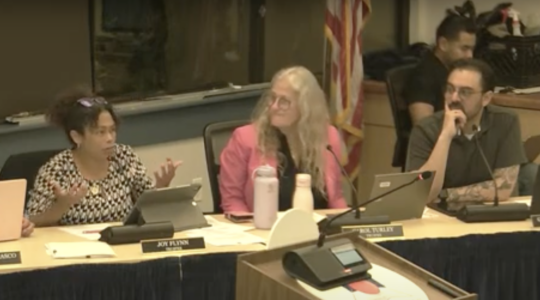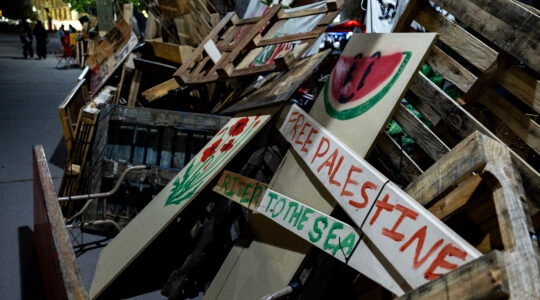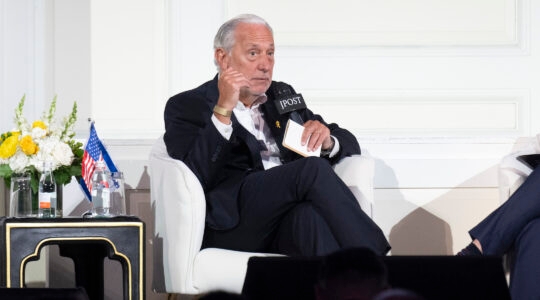WASHINGTON (JTA) — Campaigning last year for the presidency, Donald Trump said the Iran nuclear agreement was the “worst deal” he had ever seen.
It was never exactly clear, however, what he intended to do about it: Appearing at the American Israel Public Affairs Committee’s policy conference in March 2016, Trump said in the same speech that he planned to “dismantle” and “enforce” it.
As president, Trump appears to be edging toward dismantling. His administration recertified Iran’s adherence to the deal in mid-July, but it reportedly took the better part of a day for Secretary of State Rex Tillerson, Defense Secretary James Mattis and National Security Adviser H.R. McMaster to convince Trump to go along. Trump said afterward that he likely would not recertify by the next deadline, in mid-October.
And within days of recertification, Foreign Policy reported that Trump had set up a special White House team to provide him with a path out of the deal, seemingly sidelining Tillerson, a champion of recertification. Among those on the team: Trump’s top strategic adviser, Steve Bannon, and one of his deputies, Sebastian Gorka, both known for seeking to diminish America’s commitments to international alliances.
Every path out has its perils. The signatories to the 2015 deal, which trades sanctions relief for Iran’s rollback of its nuclear program, are Iran on one side and the United States, France, Britain, German, China and Russia on the other. Key to the success of any American pullout is to what degree its four partners — and other major trading partners with Iran, like South Korea and India — join in.
Should the United States walk away from the deal, the dilemma for those countries is what costs more: alienating the United States by keeping up trade with Iran, or angering domestic economic interests by going along with tough U.S. sanctions on the oil-rich country. The less persuasive the Trump administration case is for pulling out, the likelier it is that other nations would not cooperate and would continue to do business with Iran — setting the stage for increased U.S. isolation on the world stage.
“Europeans may look to contingency and fallback options if the United States unreasonably undermines the deal,” said Ellie Geranmayeh, a senior policy fellow for the Middle East and North Africa Program at the European Council on Foreign Relations.
In a conference call organized by J Street, the liberal Jewish Middle East policy group that backed the deal, Geranmayeh said European officials were planning to stage an all-out effort to keep the Trump administration from bolting.
“The challenge in the next three months is keeping the United States and the Trump character personally with keeping the deal,” she said. “In the next 90 days you’ll see a lot of activity on the Hill, in the State Department” by European diplomats.
Mark Dubowitz, who directs the Foundation for Defense of Democracies, a group that opposed the deal, said the Europeans would likely stick with the alliance, especially if the Trump administration’s aim was not to quit the deal but to reconfigure it.
“I don’t think Europeans are going to risk a transatlantic war with the administration, particularly if the administration is not looking to abrogate the deal but to improve it by addressing some of the flaws of the existing JCPOA,” he said, referring to the formal name of the pact, the Joint Comprehensive Plan of Action.
Here is a look at the possible paths out of the Iran deal for the U.S. and what the likely consequences would be.
Just walk away
U.S. assessments of Iranian adherence to the deal are governed by a law passed in 2015 with bipartisan backing, the Iran Nuclear Agreement Review Act. Under the act’s broad language, there may be room for the president to stop waiving sanctions on Iran simply because he sees the deal as inadequate. Parts of the law require Iran’s adherence with the JCPOA, but others are more fungible and depend on what the president determines are U.S. national security interests.
Under those circumstances, Trump has three options:
* Go to the joint commission governing the JCPOA and seek to have Iran declared not in compliance. The committee has eight members — the United States, Iran, Russia, Britain, France, China, Germany and the European Union, and decisions need a 5-3 vote. Obama pitched this arrangement as a guaranteed escape hatch because five partners at the time agreed on red lines: the United States, the three European countries and the EU.
Trump’s policy of distancing the United States from some aspects of the European alliance — the withdrawal from the Paris climate accord, for instance — means that comity is no longer guaranteed. He would need a substantive argument that Iran is not complying — not just that he thinks the deal is bad one.
* Exercise the U.S. option to trigger the “snapback” of international sanctions. Under this complex mechanism, the U.S. veto on the United Nations Security Council would prevent other parties from reversing the snapback and the whole deal would effectively be dead.
Busting the deal just on Trump’s say-so could exacerbate tensions with U.S. allies, experts said, and drive the other partners to establish a separate arrangement with Iran.
“It will be difficult for the Europeans to defy Trump because of the close security and economic relations the Europeans have with the United States,” Geranmayeh said. “At the same time, I don’t think we should underestimate the European capacity to do so.”
* Stop waiving sanctions, but don’t blow up the deal. This would have the advantage of satisfying Trump’s call to exit the deal while avoiding, for now, a direct confrontation with U.S. allies, who would continue to do business with Iran under the terms of the deal. What’s uncertain is whether the United States would enforce secondary sanctions — that is, punishing companies and individuals in allied countries that do business with sanctioned Iranian entities.
Walk away, but explain why
There are signs that Trump is ready to make the case to the international community that Iran is not in compliance as a predicate to pulling out. Here are some strategies:
* Iran is not complying with the “spirit” of the deal. A day after Tillerson first recertified the deal in April, Trump said at a news conference, “They are not living up to the spirit of the agreement, I can tell you that.”
The reference was to Iran’s continued testing of ballistic missiles, its human rights abuses, its military interventionism in the region and its backing for terrorism worldwide.
The notion that Iran must abide by the deal’s “spirit” has been perpetuated for the most part by those who opposed the deal in the first place. The Obama administration, which brokered the deal, and its European partners do not see it this way: The deal, they say, was designed to remove the threat of a nuclear Iran as a means of more effectively confronting Iran in other arenas.
“Show me in black and white where there’s a definition of the ‘spirit of the deal,'” Daryl Kimball, the executive director of the Arms Control Association, a group that promoted the deal, said in an interview. “The Obama administration was crystal clear that this is a nuclear deal, this is not a deal that affects Iranian behavior in other areas.”
Another tack is to insist on more intrusive inspections of some Iranian military sites, which require Iranian consent under the deal. Getting backing among U.S. allies for this gambit would require persuasive evidence that Iran is violating the deal at these sites; that’s not necessarily a given.
* Iran is not in compliance with the letter of the deal.
This strategy was behind a letter last month by four Republican senators — Tom Cotton of Arkansas, Marco Rubio of Florida, Ted Cruz of Texas and David Perdue of Georgia — urging Tillerson to declare Iran not in compliance with provisions of the deal. The letter noted reports that Iran had exceeded the limits of heavy water — needed to enrich uranium — allowed under the deal, and was operating more enrichment centrifuges than permitted.
The excesses have been noted by the U.N. inspection agency charged with overseeing the deal, the International Atomic Energy Agency, or IAEA, but have also been deemed not significant enough to declare Iran in violation — a posture the Obama administration embraced.
Conservatives say this is typical of Iranian regime behavior, pushing the envelope as far as it can, and is dangerous.
“What would be highly imprudent is to continue the Obama-era practice of offering sheepish and fainthearted certifications as a matter of course, hoping no one takes notice,” the senators’ letter said.
One possible danger in pressing forward with such an approach: The international community, which places greater stock than the Trump administration does in international organizations, would see it as nitpicking and would side with the IAEA.
* Provoke Iran into leaving the deal.
Experts touted this strategy following Trump’s election but before he assumed office. It would involve abiding by the agreement, but increasing pressure through non-deal related sanctions, targeting Iran’s government for its missile testing and adventurism, and possibly increasing U.S. military presence in the region. According to this theory, the resulting pressure by Iranian hardliners on the government of President Hassan Rouhani, which favors the deal, would lead Iran to pull out.
The problem with this idea, said Ilan Goldenberg, a senior fellow at the Center for a New American Security and an Obama administration Middle East policy veteran, is that Trump has made it so clear he wants out of the deal that it would seem by now to be disingenuous — American allies would smell a set-up.
“Nobody believes he’s acting in good faith,” Goldenberg said.
Don’t leave the deal — but make the case it must be reconfigured
The Trump administration and Congress appear to be embracing this path for now, if only by default. Congress passed new sanctions last week targeting Iran’s non-nuclear activities, and Trump keeps tacking on sanctions by executive order.
The strategy, as described by Dubowitz of the anti-deal Foundation for Defense of Democracies, would be to make the case that Iran is effectively violating the agreement.
“You make it clear that they’ve been violating incrementally, but not egregiously — but you also make it clear the sum total ends up being egregious,” he said. “Then you waive the existing statutory sanctions but you impose very tough, economically painful non-nuclear sanctions that target Iran’s malign behavior.”
That gives the United States and partners leverage to bring Iran back to the table and address the deal’s flaws, including sunset provisions that end some of the international oversight in 15 years.
JTA has documented Jewish history in real-time for over a century. Keep our journalism strong by joining us in supporting independent, award-winning reporting.






